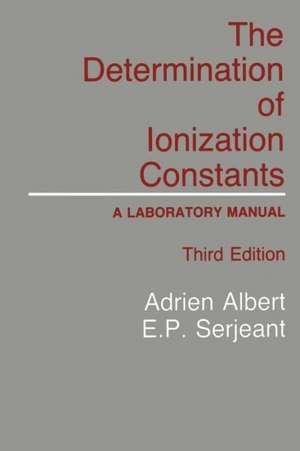The Determination of Ionization Constants: A Laboratory Manual
Autor Adrien Alberten Limba Engleză Paperback – 5 oct 2011
Preț: 384.48 lei
Nou
Puncte Express: 577
Preț estimativ în valută:
73.59€ • 79.97$ • 61.86£
73.59€ • 79.97$ • 61.86£
Carte tipărită la comandă
Livrare economică 21 aprilie-05 mai
Preluare comenzi: 021 569.72.76
Specificații
ISBN-13: 9789401089487
ISBN-10: 9401089485
Pagini: 232
Ilustrații: X, 218 p.
Dimensiuni: 155 x 235 x 12 mm
Greutate: 0.33 kg
Ediția:Softcover reprint of the original 1st ed. 1984
Editura: SPRINGER NETHERLANDS
Colecția Springer
Locul publicării:Dordrecht, Netherlands
ISBN-10: 9401089485
Pagini: 232
Ilustrații: X, 218 p.
Dimensiuni: 155 x 235 x 12 mm
Greutate: 0.33 kg
Ediția:Softcover reprint of the original 1st ed. 1984
Editura: SPRINGER NETHERLANDS
Colecția Springer
Locul publicării:Dordrecht, Netherlands
Public țintă
ResearchCuprins
1 Introduction.- 1.1 What is meant by ‘ionization constants’?.- 1.2 Why do we determine ionization constants?.- 1.3 Brief summary of the chemistry of ionization.- 1.4 The nature of pKa values.- 1.5 The shape of a titration curve.- 1.6 Methods commonly used for determining ionization constants.- 1.7 What degree of precision is required?.- 1.8 The effect of temperature on ionization constants.- 1.9 Molality and molarity.- 2 Determination of Ionization Constants by Potentiometrie Titration using a Glass Electrode.- 2.1 Apparatus for general use.- 2.2 Preparation of solutions.- 2.3 Choice of concentration for the titration.- 2.4 Details of the titration method.- 2.5 Derivation and choice of equations for calculating pKa.- 2.6 Some typical titrations (worked examples).- 2.7 Precision and accuracy. Checking the precision obtained.- 2.8 Common sources of error, and their elimination.- 2.9False constants.- 2.10 Partly aqueous solvents.- 3 Refinements of Potentiometrie Titration: Apparatus andCalculations.- A Apparatus.- 3.1 Semi-micro titrations.- 3.2 Micro titrations.- 3.3 The rapid-flow method.- 3.4 The hydrogen electrode.- B Calculations.- 3.5 Monofunctional acids and bases.- 3.6 Method of calculation.- 3.7 Diacidic bases, dibasic acids and ampholytes.- 3.8 Overlapping ionization processes.- 3.9 Polyelectrolytes.- 3.10 Accuracy of the potentiometric method.- 3.11 Non-aqueous solvents.- 4 Determination of Ionization Constants by Spectrophotometry.- 4.1 Introduction.- 4.2 Apparatus.- 4.3 Buffers.- 4.4 Acidity functions.- 4.5 Preparation of the stock solution of the unknown.- 4.6 The search for the spectra of two pure ionic species.- 4.7 The choice of an analytical wavelength.- 4.8 Preliminary search for an approximate value of pKa.- 4.9 Exact determination of pKa.- 4.10Worked examples.- 4.11 Activity corrections.- 4.12 Extensions of the spectrometric method.- (a)The pKa of a very weak acid (graphical treatment).- (b)Overlapping pKa values.- (c)Computer program for overlapping values.- 4.13 Errors, precision and accuracy.- 4.14 Common sources of error.- 4.15 Spectrophotometric determination of the pKa of a substancethat lacks an absorption spectrum.- 4.16 A rapid method for the approximate measurement of pKa.- 5 Relations between Ionization and Solubility. Determination of Ionization Constants by Phase Equilibria.- 5.1 Ionization constants in preparative work.- 5.2 Prediction of solubility from ionization constants.- 5.3 Determination of ionization constants from solubilities.- 5.4 Determination of ionization constants from vapour pressure, by partitioning between a pair of solvents, or by other phase equilibria.- 6 Determination of Ionization Constants by Conductimetry.- 6.1 Scope of the method.- 6.2 Apparatus.- 6.3 Procedure.- 6.4 Refinements of calculation.- 7 Some Other Methods for the Determination of Ionization Constants.- 7.1 Raman spectrometry.- 7.2 Proton nuclear magnetic resonance.- 7.3 Nuclear magnetic resonance using other atoms.- 7.4 Thermometric methods.- 8 Zwitterions (Dipolar Ions).- 8.1 Zwitterions compared to ordinary amphoteric substances.- 8.2 How to distinguish zwitterions from ordinary ampholytes.- 8.3 Zwitterionic equilibria: macroscopic and microscopic constants.- 9 The Ionization Constants of Typical Acids and Bases.- A Organic Section.- 9.1 The oxygen acids (monobasic).- (a) Aliphatic carboxylic acids.- (b) Aromatic carboxylic acids.- (c) Aliphatic hydroxylie acids.- (d) Aromatic hydroxylie acids (phenols).- (e) Other oxygen acids.- 9.2 The oxygen acids (dibasic).- 9.3 Sulphur acids, nitrogen acids and carbon acids.- (a) Mercaptans.- (b) Nitrogen acids.- (c) Carbon acids.- 9.4 The nitrogen bases (monoacidic).- (a) Aliphatic bases.- (b) Aromatic and heteroaromatic bases.- 9.5 The nitrogen bases (diacidic).- 9.6 Carbinolamine bases.- 9.7 Oxygen bases and carbon bases.- 9.8 Amphoteric substances.- B Inorganic Section.- 9.9 Inorganic acids.- 9.10 Inorganic bases 164.- C Biologically-Active Substances.- 10 Chelation and the Stability Constants of Metal Complexes.- 10.1 The nature of chelation.- 10.2 Methods of calculation.- 10.3 Choice of ionic medium and the preparation of standardsolutions.- 10.4 Measurement of pH and the calculation of pCH.- 10.5 Common difficulties and how they can be overcome.- 11 Appendices.- I An outline of the Brønsted-Lowry Theory.- II Comparison of classical and thermodynamic quantities.- III Calculations of hydrogen ion activity and concentration: also of hydroxyl ion activity and concentration.- IV Some effects of temperature on ionization constants.- V How percentage ionized may be calculated, given pKa and pH.- VI An outline of the theory of pH.- References.

